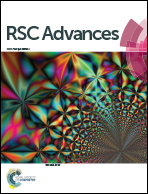Synthesis, structure and luminescence properties of new blue-green-emitting garnet-type Ca3Zr2SiGa2O12:Ce3+ phosphor for near-UV pumped white-LEDs
Abstract
A new blue-green-emitting phosphor Ca3Zr2SiGa2O12:Ce3+ has been synthesized by a conventional high temperature solid-state reaction method from the viewpoint of exploring new luminescent materials for white light-emitting diodes. The crystal structure of Ca3Zr2SiGa2O12 was investigated by the powder X-ray diffraction refinement and verified to be garnet-type with the Ia![[3 with combining macron]](https://www.rsc.org/images/entities/char_0033_0304.gif) d space group and lattice constant a = b = c = 12.5730(7) Å. The luminescence properties, concentration quenching, fluorescence lifetime, thermal quenching, quantum efficiency, chromaticity coordinates and related mechanisms of the Ca3Zr2SiGa2O12:Ce3+ phosphor were investigated in detail. The optimized phosphor shows two main broad excitation bands with peaks at 330 nm and 400 nm, respectively, in the region of 300–450 nm, and exhibits intense blue-green emission with a peak wavelength at 478 nm under 400 nm excitation. The above results indicated that the phosphor can be effectively excited by near ultraviolet light and may have potential application as a near UV-convertible phosphor for white light-emitting diodes.
d space group and lattice constant a = b = c = 12.5730(7) Å. The luminescence properties, concentration quenching, fluorescence lifetime, thermal quenching, quantum efficiency, chromaticity coordinates and related mechanisms of the Ca3Zr2SiGa2O12:Ce3+ phosphor were investigated in detail. The optimized phosphor shows two main broad excitation bands with peaks at 330 nm and 400 nm, respectively, in the region of 300–450 nm, and exhibits intense blue-green emission with a peak wavelength at 478 nm under 400 nm excitation. The above results indicated that the phosphor can be effectively excited by near ultraviolet light and may have potential application as a near UV-convertible phosphor for white light-emitting diodes.


 Please wait while we load your content...
Please wait while we load your content...